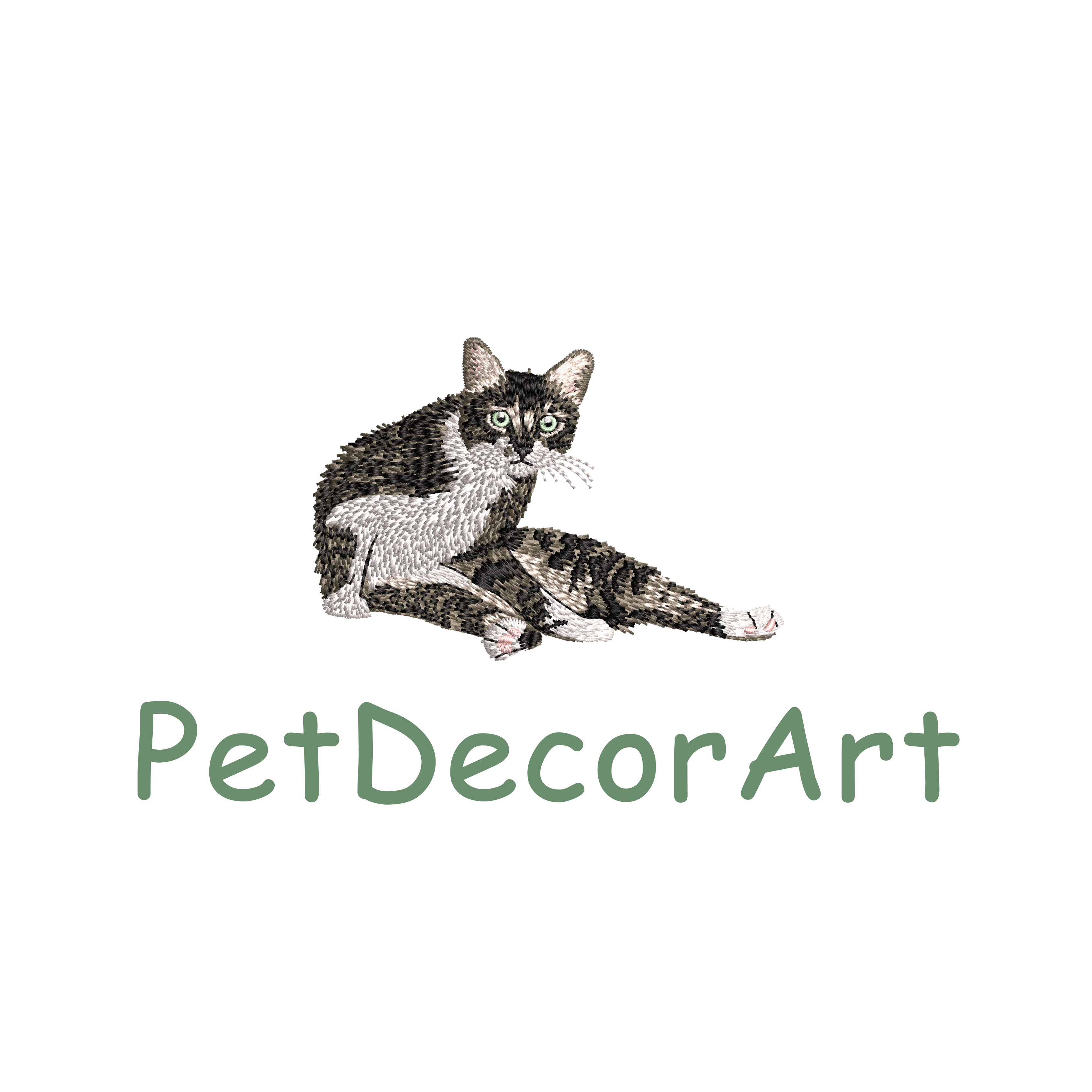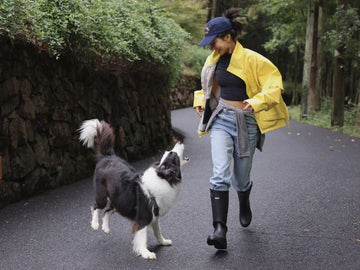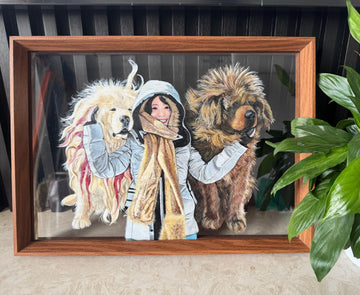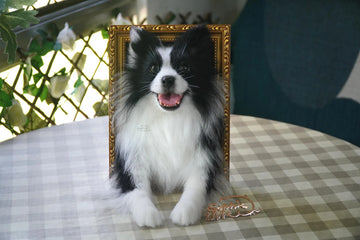“The most meaningful gifts are not about the object—they are about the story it tells.”
There’s a quiet shift that happens when a gift carries the face of someone’s pet. It’s not merely decorative; it’s emotional architecture. It bridges affection, memory, and recognition all at once. Personalized pet gifts—whether in the form of a handcrafted sculpture, a lifelike felted replica, or a timeless oil painting pet portrait—don’t just celebrate animals; they honor the invisible bonds that make companionship sacred.
This article explores why such gifts resonate so deeply from a psychological perspective, how they strengthen human connection, and why, in an era of automation, a handmade pet keepsake can feel more human than ever.
1. The Emotional Logic of Gift-Giving
Gift-giving has always been less about the thing itself and more about the emotional transaction it represents. When psychologists study why certain gifts linger in our minds, they consistently find three ingredients: recognition, intimacy, and continuity.
- Recognition: The receiver feels seen—truly seen. A personalized pet gift says, “I know how much this creature means to you.”
- Intimacy: It bridges private worlds. Pets occupy intimate spaces—morning routines, silent evenings, emotional weather systems. Reflecting that through art touches deep emotional memory.
- Continuity: The best gifts act as emotional anchors, keeping moments from fading. A pet’s likeness becomes a tangible connection to love that doesn’t end when the moment does.
In gift psychology, what we remember isn’t the object—it’s the moment we felt understood through it.
2. Why Pets Intensify Emotional Attachment
Pets occupy a singular psychological role in human lives. They are non-verbal but emotionally fluent. They mirror moods, share silence, and ground us in daily ritual. When we lose them or even just miss them, it’s not sentimentality—it’s a disruption of routine, touch, and rhythm.
That’s why gifts centered on pets have such emotional precision. They don’t just remind; they restore balance. Studies in attachment theory reveal that animals often act as “safe havens”—emotional stabilizers in moments of stress. A tangible object that symbolizes this relationship—a sculpture, portrait, or custom felt pet replica—triggers the same neural pathways associated with comfort and security.
It’s not about nostalgia. It’s about regulation. In other words, a well-crafted pet keepsake isn’t merely a “thing”—it’s a therapeutic artifact.

3. Why Personalization Feels Intimate
In consumer psychology, personalization increases perceived value not just monetarily, but emotionally. When an object contains your narrative—your cat’s peculiar squint, your dog’s tilted grin, your bird’s curious gaze—it stops being generic. It becomes relational.
Neuroscientists have observed that personalization activates the brain’s “reward center” because it connects to self-referential memory. The moment a gift references something uniquely yours, your sense of identity expands to include it. You feel both recognized and mirrored.
That’s the power behind why custom animals are more than adorable—they’re emotional surrogates that extend presence across absence.
4. Touch, Texture, and Tangibility
Digital gifts fade into the cloud. Tactile gifts stay. There’s something profoundly grounding about being able to touch what you love. The rise of handcrafted replicas—especially needle-felted animals—reflects this deep human need for texture and permanence.
A custom felt pet carries micro tactile cues: soft fibers, subtle weight, the resistance of felt beneath the fingers. These sensations activate emotional memory, the same circuits used when petting a living animal. For those grieving or living far apart from their pets, this texture becomes solace, not decoration.
Psychologists call this haptic nostalgia—the way touch resurrects memory faster than words ever could.
5. The Symbolic Power of Representation
Representation transforms affection into legacy. A painted portrait, a miniature sculpture, or a photograph freezes time not as nostalgia but as affirmation. It says: “This love existed, and it mattered.”
Oil paintings are particularly resonant. In classical art history, commissioned portraits were acts of permanence. Today, that same reverence applies when commissioning oil painting pet portraits. Each brushstroke becomes a record of presence—of fur texture, light, and warmth that no photo filter could mimic.
Unlike digital prints, oil paint carries body and scent; it matures over time. The slow-drying process allows layers of emotion to literally set into the surface—much like love, layered by years of companionship.

6. Gifts as Emotional Storytelling
Every meaningful gift tells a story. In the case of personalized pet gifts, that story is shared between species and retold by hand. The giver becomes a storyteller who bridges design and empathy.
Consider the sculptor shaping a parrot’s wing curve for a birds custom commission. They’re not just recreating feathers—they’re translating movement into memory. That is emotional storytelling in 3D form.
Similarly, a felt artist crafting a pet’s nose doesn’t just shape clay—they capture an expression of belonging. Every handmade stroke encodes affection, and every imperfection reads as authenticity. This is why people feel emotionally “seen” by the gift: it mirrors their world, not a perfect one.
7. The Psychology of Co-Creation
Another reason personalized pet gifts feel profound lies in co-creation. When recipients are part of the process—choosing colors, poses, or reference photos—they shift from passive receivers to emotional co-authors.
This phenomenon, called effort justification, means that the more someone invests in creating their gift, the more they cherish it. Participating in the design of a felted sculpture or selecting a frame for an oil painting turns the object into a shared act of care.
In co-created gifts, value isn’t measured in cost—it’s measured in participation.
8. Rituals of Use: The Everyday Sacred
Not all personalized gifts live on mantels. Some enter daily life: mugs, clocks, cushions. A mug featuring your dog’s face turns a morning routine into a micro-ritual. A framed portrait beside the entryway marks the boundary between world and home.
When a gift becomes part of ritual, it ceases to be an accessory. It becomes an environment. Every sip, glance, or touch is a repetition of love—and repetition, psychologists say, is how we encode meaning.
9. Case Studies: When a Gift Becomes Memory
Case 1 — The Long-Distance Owner
Emma adopted a rescue cat just before moving for graduate school. Her best friend commissioned a miniature felt version of the cat. During stressful nights, Emma said she would hold it while studying—it reminded her of the small creature waiting at home. The gift became a regulator for anxiety, not just nostalgia.
Case 2 — The Memorial Sculpture
After losing a cockatiel, James’s partner gifted him a birds custom sculpture. It wasn’t meant to “replace” the bird, but to honor its posture—the way it tilted its head before whistling. The sculpture sits near his record player. Every time he sees it, it feels less like loss and more like continuity.
Case 3 — The Anniversary Portrait
For their tenth anniversary, a couple commissioned oil painting pet portraits of the two dogs they’ve raised together. Framed side by side, the paintings now form the visual “heart” of their living room. Guests don’t just compliment the art—they comment on how peaceful the room feels.

10. Personalization as Identity Mirror
We often define ourselves through what we love. In modern psychology, this is called the self-extension theory: possessions can become part of one’s identity when they symbolize relationships, achievements, or deeply held values. A personalized pet gift becomes an identity mirror—reflecting not just ownership but connection.
For many, it’s not “a portrait of my dog.” It’s “a portrait of my life with him.” That subtle linguistic shift—from possession to partnership—reveals the psychological weight behind these gifts.
11. The Social Dimension of Personalized Gifting
Beyond emotion, there’s social intelligence. A personalized pet gift demonstrates attentiveness and empathy. It signals: “I didn’t just spend money—I paid attention.”
In a culture of convenience, attentiveness is luxury. Taking the time to commission a hand-felted sculpture or to coordinate with an artist shows relational investment, something no pre-wrapped product can simulate.
12. Economic Value vs. Emotional Worth
Interestingly, most people underestimate how much recipients value personalized gifts. Research by Harvard’s Behavioral Insights Lab found that recipients consistently rate personalized or handmade gifts as more meaningful than their cost would suggest. Why? Because the “cost” measured in effort outshines the price tag.
A $200 portrait can hold more emotional gravity than a $2,000 gadget because it carries narrative density. It’s not about luxury—it’s about presence embodied in form.
13. Ethical and Emotional Considerations
Personalization, however, comes with responsibility. Ethical gifting involves consent, respect, and sensitivity—especially with memorial pieces. When gifting a portrait after a loss, ensure timing feels gentle. Sometimes a small piece—a felted paw or tag sculpture—is a better entry point than a grand painting.
It’s equally important to honor sustainability. Use non-toxic dyes, responsibly sourced wool, and FSC-certified frames. The gesture of care should extend beyond emotion to the planet that makes these materials possible.
14. Choosing the Right Form: A Practical Guide
- For tactile comfort: Choose a custom felt pet or soft 3D replica. Ideal for people who miss physical touch or travel often.
- For visual serenity: Go with oil painting pet portraits. Perfect for homeowners who love timeless aesthetics.
- For minimalist collectors: Commission a birds custom sculpture—elegant, compact, modern.
- For families or couples: Pair a replica with a framed note or adoption-day date. This mix of touch and word amplifies emotional resonance.
15. Long-Term Impact: Why They’re Kept Forever
Ask someone about the best gift they’ve ever received. Chances are, it’s not expensive—it’s personal. Decades later, people rarely remember brand names, but they remember who saw them clearly. Personalized pet gifts endure because they symbolize that rare human experience: to be seen in one’s tenderness.
These are the objects people pack first when they move, rescue after fires, or keep on nightstands through heartbreak. They outlast trends because they outlast explanation.
16. Frequently Asked Questions
Do I need professional photos for a custom portrait?
No. Artists can work from candid phone photos as long as they capture the pet’s expression clearly. Include at least one side view and one “favorite moment.” Emotion beats resolution.
Are felted replicas only for memorials?
Not at all. Many owners commission why custom animals for living pets—as gifts, decor, or travel companions that echo comfort while apart.
What’s the price range for handmade pet art?
Small felted replicas often start around US$79, while hand-painted oil portraits range between US$189–699 depending on size and frame. Always allow extra time for handcrafting.
How do I make a memorial gift feel hopeful, not heavy?
Keep the palette light, scale modest, and add an element of life—a plant nearby, a soft lamp glow. Memory can be warm, not solemn.
Conclusion: Gifts That Stay, Even When Time Moves On
In the end, personalized pet gifts are not about pets alone—they’re about love in its purest, most uncomplicated form. They remind us that affection doesn’t need translation; it only needs expression. Whether it’s a lifelike custom felt pet, a poised birds custom piece, or an elegant oil painting pet portrait, each medium translates care into matter, sentiment into sculpture, memory into something that can be touched again and again.
Because the most intimate gifts aren’t loud. They’re the quiet ones—made by hand, given with thought, and held with both hands long after the occasion has passed.




